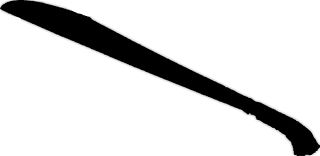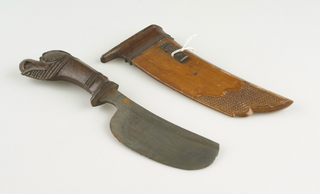
A kalis is a type of Philippine sword. The kalis has a double-edged blade, which is commonly straight from the tip but wavy near the handle. Kalis exists in several variants, either with a fully straight or fully wavy blade. It is similar to the Javanese keris, but differs in that the kalis is a sword, not a dagger. It is much larger than the keris and has a straight or slightly curved hilt, making it a primarily heavy slashing weapon.

Mandau is the traditional weapon of the Dayak people of Borneo. It is also known as Parang Ilang among the Bidayuh, Iban and Penan people, Malat by the Kayan people or Baieng by the Kenyah people or Bandau by Lun Bawang or Pelepet/Felepet by Lundayeh. Mandau is mostly ceremonial. However, a less elaborate version called Ambang is used as an everyday practical tool.

Niabor is a curved sword from Borneo, a characteristic weapon of the Sea-Dayaks.

Langgai Tinggang is a traditional sword of the Sea Dayak people, originating from Borneo. The name Langgai Tinggang means "the longest tail-feather of a hornbill".

Jimpul is a traditional weapon of the Sea Dayak and Kenyah people from Borneo. It is often thought that the Parang Jimpul may be considered as a hybrid between the Mandau and Langgai Tinggang. The Parang Jimpul is an intermediary form between the Mandau and the Langgai Tinggang dating from c. 1870-c. 1885.

The Pandat is the war sword of the Dayak people of northwest Borneo and is never used as a tool. On October 18, 2016, this weapon was featured in season 3 episode 9 of the American bladesmithing competition series Forged in Fire.

Parang Nabur is a sword that originates from Banjarmasin, South Kalimantan, Indonesia. Most of these swords were made during the Banjarmasin Sultanate period in the 19th century.

Balato is a sword that originates from Nias, an island off the west coast of North Sumatra, Indonesia.

A Piso Halasan is a traditional sword of the Batak people from North Tapanuli Regency, North Sumatra, Indonesia.

Si Euli is a traditional dagger or knife that originates from Nias, an island off the west coast of North Sumatra, Indonesia. There are versions of this knife worn by men or for daily use.

Parang Chandong is a traditional chopper used by the Dayak people of the Baram River in Borneo.

Golok rembau is a type of golok in a shape of the Tumbok Lada, but in a larger version originating from Sumatra, Indonesia. It is also commonly found in Malaysia.

The bangkung or bangkon,is a slashing weapon, meant to deliver hacking-type blows. It is a short sword originating in the Sulu Archipelago of the Philippines. The bangkung was used primarily by the Moro people of the Sulu and is not associated with Moros in other areas such as Mindanao, although it is sometimes found in coastal regions. While the bangkung is a very effective sword, it was not popular unlike the panabas and the pirah and for this reason it is one of the most rarely found Moro edged weapons. Few were produced and even fewer survive.

Parang Latok is a sword from Borneo in Sarawak, Malaysia; where it is regarded as the national weapon of the Sarawakian Malay people and the Bidayuhs, and as well as Kalimantan, Indonesia. It also functions as a machete.

Dao is the sword of the Naga people and Mizo people of Northeastern India, mainly in the Indian states of Nagaland, Mizoram, Manipur and Assam. The sword, with its wooden hilt, and unique square form is used for digging as well as used in historical warfare. In modern times, it is generally used for cutting meat and wood.

A kudi or kudhi is a bladed tool from Banyumas, Indonesia.

The Piso Sanalenggam is a type of broad sabre from North Sumatra, Indonesia. This sword is a weapon of war during the times when feuds were frequent among the different Batak groups. Piso Sanalenggam that were made by datu priests from the Dairi Regency region, is used for the preparation of medicine and magical substances.

Hemola or Hemala is a traditional sword of the Savu people from Indonesia. It is also called Tafa by the neighboring Rotenese people.

The Dohong is a dagger or short war sword from Borneo. The name is used figuratively to imply bravery. In other parts of Borneo, it is simply referred to as Mandau. The Dohong is considered an ancient Dayak sword that was used long before the Mandau was introduced. It is believed to be the oldest weapon of the Dayak people. According to folklore, the first people who owns the Dohong are the forefathers of Dayak people, namely Raja Sangen, Raja Sangiang, and Raja Bunu.

The Bendo is a traditional bladed tool from Java, Indonesia. Betawi people would regard the Bendo as a domestic household tool and sometimes it is also called golok dapur, which means a "kitchen golok".

























